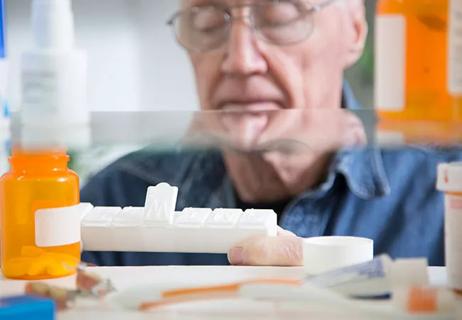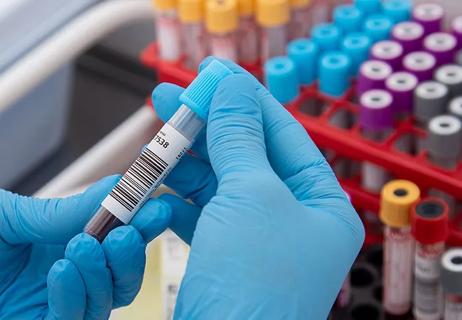It’s important to consider this often-missed diagnosis

Cleveland Clinic is a non-profit academic medical center. Advertising on our site helps support our mission. We do not endorse non-Cleveland Clinic products or services. Policy
Hyperthyroidism is a diagnosis often missed in older adults. Thyroid disorders affect more than 10 percent of those over age 80. About 1.3 percent of those over age 65 develop overt hyperthyroidism with suppressed pituitary thyrotropin (TSH) and elevated free T3/T4 levels, and about 2.1 percent develop subclinical hyperthyroidism (SH).
A high index of suspicion is required to diagnose hyperthyroidism in older adults because they have few symptoms, and many age-related physiological changes can affect thyroid function test results.
Typical symptoms (such as weight loss, fatigue, tremors, palpitations, atrial fibrillation, anxiety, depression, shortness of breath, heat intolerance, eye symptoms and anemia) may be absent, or attributed to aging or another chronic illness.
In a cross-sectional study in the United Kingdom, older adults typically presented with fewer symptoms than younger adults. They were also more likely than younger adults to display weight loss and shortness of breath. Atrial fibrillation was more likely to be seen with increasing age, male gender, more severe biochemical disease and an underlying diagnosis of toxic nodular hyperthyroidism.
Hyperthyroidism also increases the rate of bone turnover, interfering with osteoblast activity as well as causing muscle weakness and loss of lean body mass. Hyperthyroidism thus increases the risk of gait abnormalities, falls and osteoporosis, potentially increasing the risk of injurious fracture.
While Graves’ disease is the most common cause of hyperthyroidism in younger patients, toxic multinodular goiter (MNG) is the dominant cause in aging patients. In geographic regions with low or borderline iodine intake, nontoxic goiters are more likely to convert to toxic ones over time.
Pre-existing nontoxic MNG may also become toxic after a large iodine load is administered for radiocontrast imaging or through medications such as amiodarone and interferon alpha.
Subacute/silent thyroiditis is less common among older adults, and central hyperthyroidism, due to TSH secretion from the pituitary gland, occurs rarely.
Amiodarone-induced hyperthyroidism, of particular concern in older adults, can develop because of increased hormone production in pre-existing MNG or Graves’ disease and/or increased release from the gland (destructive thyroiditis). Hence, checking thyroid function before initiating amiodarone and then every three to six months is suggested.
The risk of progression to overt hyperthyroidism is 0.5 to 1 percent per year if SH goes untreated. Once SH is detected, it is reasonable to repeat the serum TSH at three- or six-month intervals. Some data suggest that a subnormal serum TSH may spontaneously resolve, especially if levels are > 0.05 mU/L.
Adverse clinical outcomes for untreated SH are controversial. Some, but not all, longitudinal studies demonstrate increased cardiovascular mortality in adults 60 years or older with SH (TSH < 0.5 mU/L). The relationship between risk of atrial fibrillation and SH in older adults appears to be less controversial. There may also be a risk of impaired cognitive function.
A simple TSH lab measurement is a good, sensitive initial test for thyroid function. A suppressed TSH should prompt testing for free T3-T4 levels. TSH-receptor antibodies may be helpful when the clinical diagnosis is uncertain and radionuclide imaging is contraindicated. These antibodies may not be elevated in mild Graves’ disease. Looking at TSH receptor antibodies (TRAb) using a second-generation thyrotropin-binding inhibitory immunoglobulin (TBII) assay may minimize false negatives.
Thyroid function tests must be interpreted in the context of concurrent use of medications, especially glucocorticoids, amiodarone, lithium, dopamine, heparin and beta blockers. A detailed current and past drug history is imperative. Hypothalamic or pituitary disorders, psychiatric conditions and states of acute stress, such as starvation or major surgery, can influence thyroid levels significantly.
Radioactive iodine (I131) scans can help differentiate Graves’ disease, thyroiditis, toxic uninodular goiter and MNG. When I131 imaging is not useful because of recent iodine exposure, color Doppler flow ultrasound can distinguish subtypes of amiodarone-induced thyrotoxicosis and differentiate Graves’ disease from destructive thyroiditis.
Graves’ disease. Graves’ hyperthyroidism can be treated with I131 therapy, antithyroid medication or total thyroidectomy. Radioactive iodine is the primary treatment in the United States. Surgery would be indicated for a suspicious or malignant thyroid nodule, primary hyperparathyroidism or an obstructive goiter. Subtotal thyroidectomy has an approximately 30 percent recurrence rate and may be less desirable than total thyroidectomy. The remission rate for antithyroid medications alone, even after one to two years, is only 30 percent.
Toxic MNG. I131 therapy may be less useful in toxic MNG than in Graves’ disease. The risk of treatment failure or the need for repeat treatment is less than 1 percent following near-total/total thyroidectomy, compared with a 20 percent risk for retreatment after I131 therapy.
Toxic adenoma. The risk of treatment failure is less than 1 percent after surgical resection.
Subclinical hyperthyroidism. Pharmacological treatment of SH in older adults may be started if TSH is below 0.1 mU/L (with 0.5 mU/L being the lower limit of the normal range). Consider treatment if TSH is 0.1 to 0.5 mU/L when there are comorbidities such as atrial fibrillation, weight loss and osteoporosis.
Methimazole (MMI) and propylthiouracil (PTU) are the two most commonly used thionamide drugs; MMI is considered first-line treatment due to safety and convenience. MMI has the benefit of once-a-day administration and a reduced risk of major side effects such as agranulocytosis and/or fulminant hepatic necrosis.
Higher doses (10 to 20 mg daily) are advised at the start of therapy to restore euthyroidism. The dose can be decreased to maintenance levels (generally 5 to 10 mg daily) afterward. Should a serious allergic reaction to either MMI or PTU occur, prescribing the alternate drug is not recommended.
Higher doses (10 to 20 mg daily) are advised at the start of therapy to restore euthyroidism. The dose can be decreased to maintenance levels (generally 5 to 10 mg daily) afterward. Should a serious allergic reaction to either MMI or PTU occur, prescribing the alternate drug is not recommended.
Some elderly patients who have slightly but persistently abnormal TSH, and free T4 and T3 levels but no evidence of true thyroid dysfunction can be followed without intervention. In certain cases, treatment with beta-adrenergic blockade may be sufficient to control the cardiovascular-related morbidity from SH.
It is important to diagnose hyperthyroidism in older adults in order to avoid significant comorbidity. The management of both overt and subclinical hyperthyroidism should be tailored to the older patient, considering severity, cause, comorbid conditions and estimated life expectancy.
Dr. Makin is an endocrinologist in the Department of Endocrinology, Diabetes and Metabolism. She can be reached at makinv@ccf.org or at 216.444.0539.

Screening and medication key to better outcomes

While the skeletal effects of nutrient deficiency are well-known, it’s important to consider how deficiency impacts the endocrine system

The tool can provide better clarity on evaluation of indeterminate thyroid nodules, reduce the number of unnecessary surgeries and help providers tailor patient care

Guidance for counseling patients on the use of one of the most common daily supplements taken in the US

Two case studies illustrate why it’s important to look at DXA data holistically when treating patients with fracture risk

Because treatment options are reserved for classic Cushing’s, monitoring changes is critical in the management of subclinical Cushing’s

Although the diagnosis and treatment processes are often straightforward, it’s important to be timely with initiating both

Following a PCP referral, patients often meet with several specialists, including an endocrinologist who helps them achieve their GAHT goals